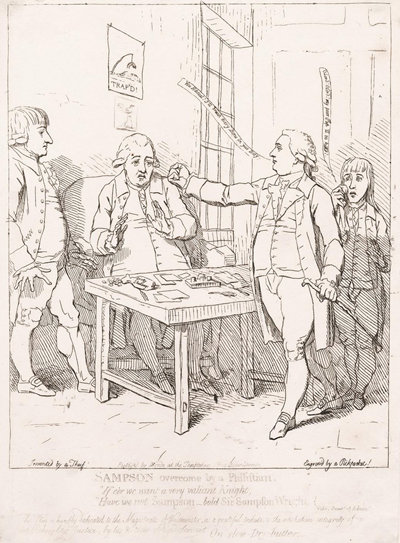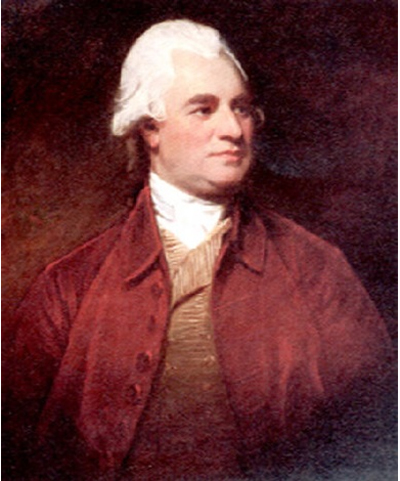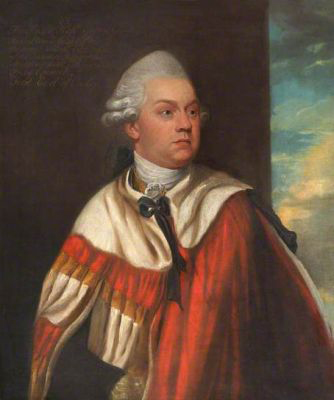Sampson Overcome by a Philistian
In the biblical Book of Judges (14-16), Samson was a judge of Israel for 20 years. He was also a man of incredible strength, killing a lion with his bare hands and knocking out an entire army of Israel's enemies, the Philistines, with the jawbone of an ass.
In Gillray's print, however, the Bow Street Magistrate and judge, Sampson Wright, is portrayed as anything but strong and brave, cowering before the clenched fist of an angry "Philistine" (Sir George Onslow) who threatens him: "You Rascal, I'll Break every Bone in your Body." On one side of him is Nicholas Bond, his disconcerted clerk, and on the other, Wright's son, who cries out "O Lord O Lord, my poor Pap'll be killd!"

© Lewis Walpole Library, Yale University
In the 18th century, policing was in its infancy. Before 1749, law enforcement was basically in the hands of private citizens. Rewards were advertised in newspapers to identify and capture criminals and/or return stolen goods. Not suprisingly, this practice was open to a variety of abuses and created its own specialized profession of thief-taking. For instance, thief-takers could entrap and lie about individuals in order to secure the reward. Or they could blackmail the criminals themselves, demanding more money than the reward to maintain their silence.
With the ascent of the Fieldings (Henry, the novelist and John, his blind half brother) to the post of Bow Street Magistrate, the beginnings of a legitimate police force (the Bow Street Runners) was established to provide an official (and more honest) alternative to self-appointed thief-takers. Abuses were still possible, and defense lawyers like William Garrow would closely interrogate Bow Street runners and thief-takers alike to uncover holes in their stories. But, in general, by 1780 when John Fielding was succeeded by Sampson Wright as Bow Street Magistrate, the Bow Street Runners were generally respected and credible. Two years later in September of 1782, Wright, like the Fieldings before him, was knighted for his service, becoming "Sir Sampson Wright." This print and the portrait of Wright below by George Romney were likely prompted by that honor.

Sir Sampson Wright
[~1782?]
© Artnet
Gillray, for one, does not see this as cause for celebration. Indeed all four of his prints including Sir Sampson are highly critical of the man and his office. In The W-st-r Just-Asses a Braying-or-the Downfall (1782), he portrays Samson and his clerk as asses. In Swearing to the Cutting Monster or a Scene in Bow Street (1790), he shows Wright as simply prurient in his "examination" of a young woman. And in The Battle of Bow-Street (1788) he depicts Sir Sampson again as a coward, this time on his knees before the clenched fist of the Whig Richard Brinsley Sheridan during the violent and hotly contested Westminster by-election.
Here in Sampson Overcome, Gillray provides a number of details connecting Sir Sampson and his office with the most common judicial abuses. Directly over his head, for instance, is a picture labeled Trap'd, suggesting that Sir Sampson is familiar with (and perhaps guilty of) the practice. At the feet of the clerk, Nicholas Bond, the mock signature line includes "Invented by a Theif!" (sic) implying the collusion of the official recorder with the inventions of the accused criminal. And then there is the publication line that says, "Publishd by Bonde at the Thieftakers office Bow Street" suggesting that the whole office in Bow Street is part of a thief-takers operation.
But the most important and obvious abuse is what is shown in the confrontation between Sir Sampson and the Philistian, where Sir Sampson is clearly being intimidated by the threat of violence from Lord Onslow. Thomas Wright and R.H. Evans suggest that the print (and Onslow's reaction as portrayed in the print) may have been prompted by the recent raids upon houses in Westminster where illegal E O tables for gambling were set up and frequented by high rollers like Charles James Fox and the Duchess of Devonshire.

© WikiData
But I have been unable to discover that Lord Onslow had an E O table or that he was ever involved in illegal gambling. What I have discovered, however, suggests that the impetus for the print may have been quite different and helps to explain the rather curious mock dedication:
This Plate is humbly dedicated to the Magistrates of Westminster, as a grateful tribute to the unshaken integrity of a late Beknighted Justice, by their obliged Servant On – slow – Dry – Butter.'
In May 1781, as reported (extensively) in the London Courant and (briefly) in the Caledonian Mercury (both reproduced in Rictor Norton below), Edward Onslow, the younger son of Lord Onslow, was involved in a homosexual incident at an Exhibition of the Royal Academy, in which he was reported to have approached a young Irishman and "applied his hand to a certain part of his body, in a manner that seemed to convey obscene and unnatural views." But when the offense was eventually repeated, and brought to the attention of the Magistrates, the Irishman
who so nobly defended the cause of human nature, and his own character was over-whelmed with torrents of abuse in lieu of that justice he came to solicit; and if any retort was attempted by him, or his friends, they were threatened to be committed. — As to the noble Lord [Onslow], he raved like a Bedlamite, calling the prosecutor [i.e. the Irishman] and his friends conspirators, villains, in league against the life of his son, with a thousand other opprobrious names.
The result was that the unnamed Magistrate in question "thought fit absolutely to refuse committing [young Onslow]" and the following notice appeared some days later in the Caledonian Mercury, Monday 14 May 1781):
The Honourable Mr E—d O—w, accused of an unnatural attempt upon a Mr Maccartey, an Irishman, a few days ago, at the exhibition at Somerset-house, this day absconded, from which circumstance his guilt is generally inferred. Lord O—w is said to be in a state of distraction on this occasion.
That Gillray was alluding to this incident is, if not absolutely confirmed, substantially strengthened by the reference to Dry – Butter. According to Rictor Norton (see below), Samuel Drybutter was a toyman, a seller of luxury goods such as jewelry, watches, and snuff boxes, working mainly from a shop (or stall) in Westminster Hall. He was also, however, "a notorious sodomite," and from 1770 until his death in ~1787 was frequently arrested (and sometimes jailed) for various incidents involving solicitation and sodomy. One of these incidents with a grenadier, was, in fact, brought before Sampson Wright as Justice in 1771 and dismissed. And in 1781, the year before Sampson Overcome by a Philistian appeared, The Complete Modern London Spy (1781) quoted by Norton, records the following conversation which alludes to Drybutter
"do you observe that man who is now sauntering towards Covent garden? – he is one of those wretches, once almost unknown in England. He subsists by gratifying the unnatural vices of his own sex; in short, he is the companion of an infamous fellow, whose name is Dr—b—r, and who, though well known to be guilty of this horrible crime, has hitherto evaded all attempts to bring him to condign punishment."
Whatever the specific reason—aristocratic intimidation or a payoff in "dirty shillings" which we can see on Sir Sampson's desk—Gillray strongly implies that Onslow and Drybutter both owe their current freedom to the "beknighted" Sir Sampson's cowardice and lack of integrity.
Sources and Reading
- Commentary from the British Museum on Sampson Overcome by a Philistian.
- "Samson," Wikipedia
- "Bow Street Runners," Wikipedia
- "Thief-taker," Wikipedia
- "Garrow and the Detectives: lawyers and policemen at the Old Bailey in the late eighteenth century," Crime History & Societies
- The Beauties of Administration
- Rictor Norton (Ed. ) "Incident at the Royal Academy" [Edward Onslow] Homosexuality in Eighteenth-Century England: A Sourcebook
- Rictor Norton (Ed. )"The Macaroni Club" [Samuel Drybutter] Homosexuality in Eighteenth-Century England: A Sourcebook
- "George Onslow, 1st Earl of Onslow," Wikipedia
- Thomas Wright and R.H. Evans, Historical and Descriptive Account of the Caricatures of James Gillray #379.
- Thomas Wright and Joseph Grego, The Works of James Gillray, the Caricaturist; With the History of His Life and Times, p. 43.
Comments & Corrections
NOTE: Comments and/or corrections are always appreciated. To make that easier, I have included a form below that you can use. I promise never to share any of the info provided without your express permission.